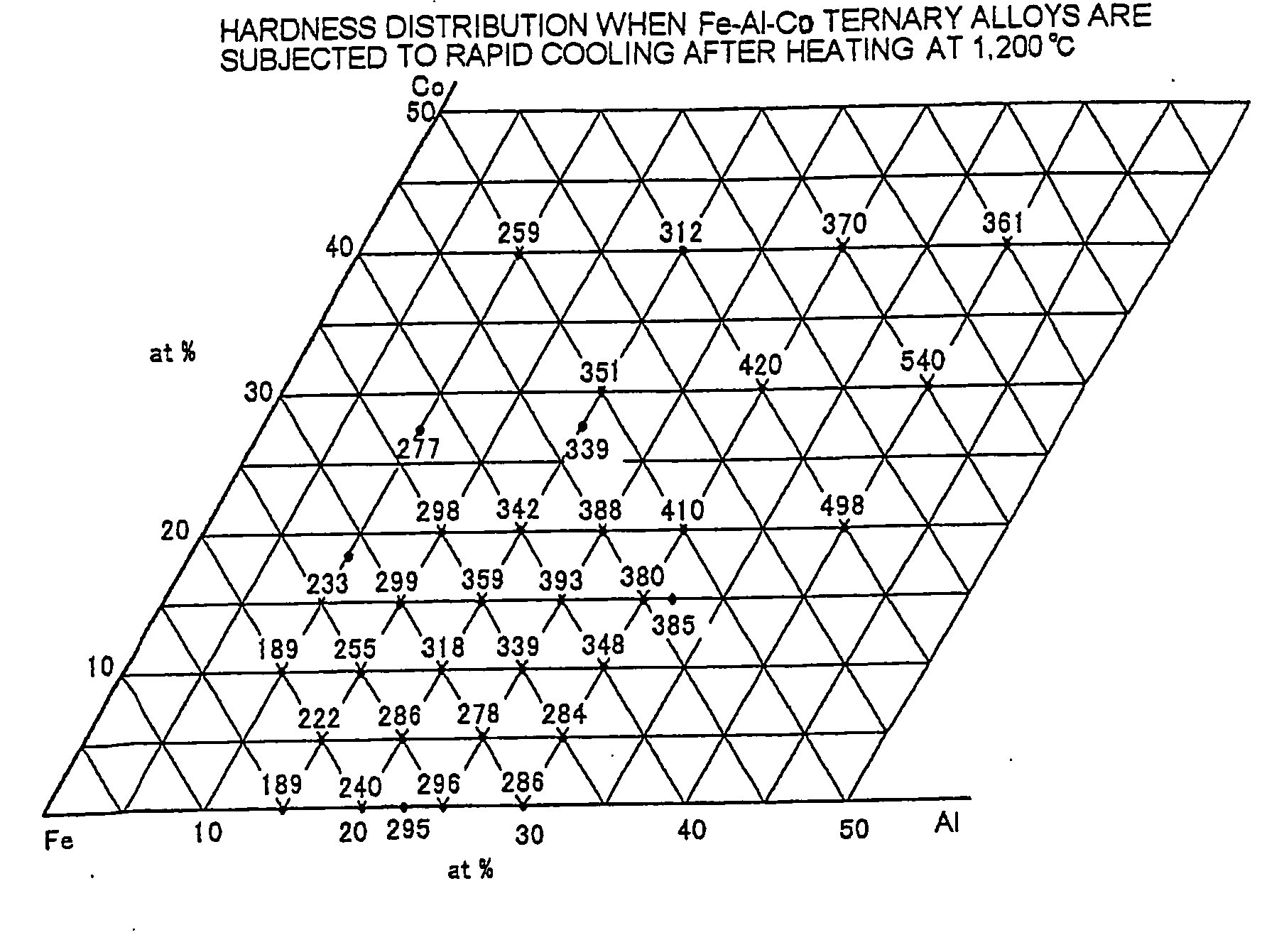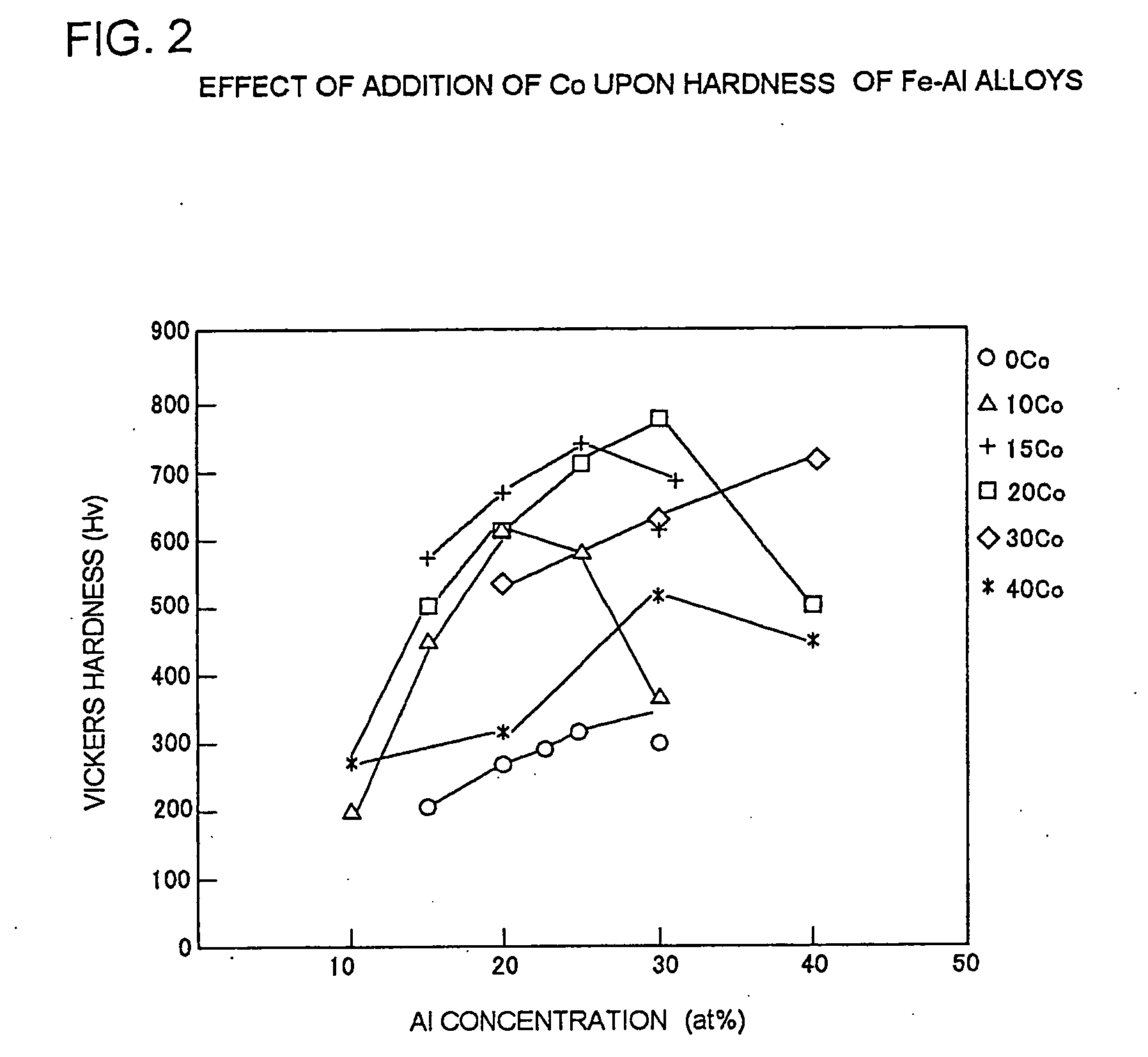Contact material, composite sintered contact component and method of producing same
- Summary
- Abstract
- Description
- Claims
- Application Information
AI Technical Summary
Benefits of technology
Problems solved by technology
Method used
Image
Examples
example 1
[0078] Various alloys having different compositions were prepared using electrolytic iron (99.95 wt %), Al and Co. These alloys were melted, produced and forged under a vacuum atmosphere and then cut into small pieces, forming specimens. The relationship between the magnetic transition temperature (Curie point (° C.)) and hardness of each alloy and thermal treatment was checked.
[0079]FIG. 1(a) shows the Vickers hardness distribution of Fe—Al—Co ternary alloys which contain 0 to 40% by atom Co and 0 to 40% by atom Al and were rapidly cooled after heating at 1,200° C. FIG. 1(b) shows the Vickers hardness distribution of these alloys which were further subjected to aging treatment at 600° C. for 10 hours after the rapid cooling. It is understood from these figures that while a slight tendency for hardening is found in the rapidly cooled alloys (shown in FIG. 1(a)) containing 25 to 40% by atom Al and 15 to 30% by atom Co, a significantly hardened zone exists in the alloys which underwe...
example 2
[0083] Evaluations of the wear resistance of Fe ordered phases were conducted in the following procedure: Cylindrical specimens having a diameter of 10 mm and length of 50 mm were prepared from ingot materials of the compositions as shown in TABLE 1. After the hardness of these specimens had been adjusted by controlling the time required for age hardening at 500° C. and 600° C., the specimens of the contact materials were respectively pressed against a Portland cement disk containing 20 wt % SiC under an oil-lubricated condition. Then, the wear resistance of each material to sediment was evaluated.
TABLE 1Fe BASE ORDERED PHASE ALLOY INGOT MATERIALS (wt %)NoFeAlCoNiMnSiHARDNESS(Hv)1Bal.123002Bal.12207153Bal.12206704Bal.12105405Bal.103325
[0084]FIG. 4 shows a conceptual view of a tester and test conditions. In this test, a S45 comparative material which had undergone quenching and tempering so as to have a Vickers hardness of 500 was mounted on the tester together with the specimens, ...
example 3
[0085] In this example, each of the alloys shown in TABLE 2 was melted in vacuum and then formed into a sheet-like shape by hot forging and hot rolling at 1,000 to 1,150° C. This sheet-like material was cut and rounded, thereby obtaining a bushing machined into the shape shown in FIG. 6. The bushings thus prepared were used as sliding test specimens and adjusted so as to have different hardnesses by controlling the processing time taken for aging at 600° C. Used as comparative examples were a carburized bushing (Comparative Example 1) formed from SCM420 case hardening steel and having a surface carbon concentration of about 0.8 wt %; an S43C quenched, tempered bushing (Comparative Example 2); and a high-strength brass quarternary material (Cu, 25 wt % Zn, 5 wt % Al, 3 wt % Mn, 2.5 wt % Fe) (Comparative Example 3).
TABLE 2COMPOSITION OF Fe BASE ORDERED PHASE ALLOYS FORSLIDING TESTS (wt %)HARDNESSHARDNESSAFTER RAPIDAFTER AGINGNoFeAlCuCoNiSiCOOLING (Hv)(Hv)6Bal.51701757Bal.122953008Ba...
PUM
| Property | Measurement | Unit |
|---|---|---|
| Percent by volume | aaaaa | aaaaa |
| Percent by volume | aaaaa | aaaaa |
| Transition temperature | aaaaa | aaaaa |
Abstract
Description
Claims
Application Information
 Login to View More
Login to View More - R&D
- Intellectual Property
- Life Sciences
- Materials
- Tech Scout
- Unparalleled Data Quality
- Higher Quality Content
- 60% Fewer Hallucinations
Browse by: Latest US Patents, China's latest patents, Technical Efficacy Thesaurus, Application Domain, Technology Topic, Popular Technical Reports.
© 2025 PatSnap. All rights reserved.Legal|Privacy policy|Modern Slavery Act Transparency Statement|Sitemap|About US| Contact US: help@patsnap.com



